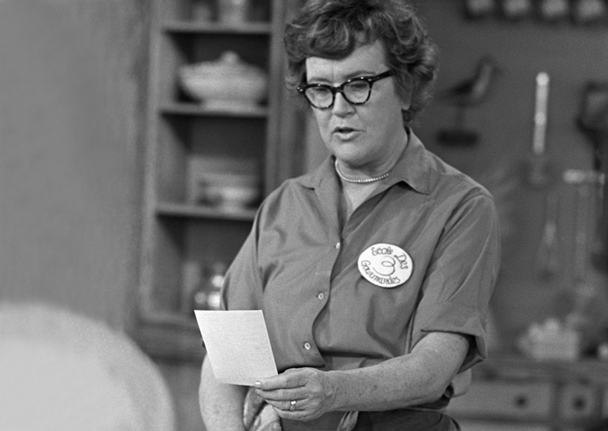First things first. Julia Child was not America’s original television cook. (That would be Dione Lucas.) She never dropped a duck on the floor, never had asthma (she was just a heavy breather), and never over-imbibed on those early shows. (All that “wine” was Château Gravy Master.) Those are the myths.
Now for the reality.
In 1962, the United States was in its food infancy. You couldn’t find a garlic press this side of Paris; asparagus were mushy, stringy things that came in cans; and as far as most people were concerned, a leek was a problem with the roof. Americans thought of food the way they thought of gasoline: You bought it cheap and put it in to keep the machine moving.
Television was also relatively young. There would probably never be another time when a gangly (as in six feet two inches tall) 50-year-old with a warbly voice (once described as capable of “making an aspic shimmy”)—a woman who called herself the French Chef though she was neither French nor a chef—could occupy the same coveted prime-time slot as people like Edward R. Murrow and Milton Berle. But Julia Child captured the hearts of American TV viewers from the start, primarily because her accomplishment extended well beyond her medium. She taught America how to enjoy food.
Julia Carolyn McWilliams was born in Pasadena, California. Her mother’s family came from old New England money and her father was a successful entrepreneur. A fun-loving tomboy with a wry sense of humor, Child graduated from Smith College in 1934 with plans to become a writer. Unfortunately, The New Yorker didn’t want her. Never one to sit around and mope, she joined the Office of Strategic Services, where, two years later, she met her husband, Paul Child, a photographer, artist, and bon vivant ten years her senior. En route to the couple’s first posting in Paris, they stopped in Rouen, where Child tasted sole meunière in browned Normandy butter for the first time. Thus began her lifelong love affair with food.
After the war, Child enrolled at the Cordon Bleu, where her infatuation with cooking only deepened. Beginning in 1951, she worked with friends and fellow cooks Simone Beck and Louisette Bertholle on a ten-year research and writing project that resulted in Mastering the Art of French Cooking. When an editor at Houghton Mifflin saw the mountainous manuscript and promptly deemed it too long and complicated, Judith Jones, an editor at rival Knopf, snapped it up for a mere $1,500. Child had never thought about a career in television, but at the time of the book’s publication, in 1961, promotional duties generally entailed an appearance or two. So she went on air armed with a hot plate, a lipped pan, and the desire to tell people everything she knew. She made a perfect omelet and became an instant hit.
“Julia thinks of herself as a missionary instructing a noble but savage race in a civilized art,” Harper’s editor Lewis Lapham wrote in 1964 to explain Child’s connection with audiences. It’s a nice quote, but the assessment was way off. Julia was never condescending. Her fervor came from a different place.
“She was a gifted scholar, she knew her stuff, and she was confident at a time when women generally weren’t,” says producer Russell Morash, who collaborated with Child for some 30 years. “Moreover—and this was important in those days of television—she could hold a conversation with herself.”
The managers at WGBH, Boston’s public television station, spotted Child’s potential and commissioned an entire series. She named it The French Chef not to be highfalutin but because the three short words fit neatly into the newspaper TV listings. Ever the practical one.
At the time, WGBH had no studio and barely any budget. Morash found a demo kitchen of sorts in a creaky old Cambridge building that had been built by the Boston Gas Company to promote stoves to housewives. Unfortunately for Child, it was only a part-time arrangement, so for every taping, the star, her husband, and a devoted gaggle of friends bundled pots, pans, spoons, and ingredients (raw and cooked to various degrees) into the car, then lugged them up to the studio in a freight elevator. They’d tape one episode in the morning, break for lunch—anything from stuffed goose with prunes to corned beef hash from a can—and tape another in the afternoon. At day’s end, they’d wash the dishes in the toilet and drag all the equipment back down to the car. This went on for years, with Child earning $50 per episode, food not included.
Because film was expensive, there was little room for error. At first, Child’s biggest battle was with the clock. In an early episode featuring onion soup, she was so anxious to cram every step into her precious half hour that she ended eight minutes early and had to sit at the table chatting to the camera with only her Gravy Master for company. No one can converse with herself for that long, so the episode was scrapped.
Child eventually learned to use idiot cards and, more importantly, to turn her mistakes to her advantage. When someone rang the elevator bell during filming one afternoon, she just looked up at the camera and said, “That must be the plumber; about time he got here,” and pushed on.
That good-natured Yankee determination is still in evidence today. Child, 91, lives in a condominium complex in the pretty coastal village of Montecito, California. Her body has let her down, as bodies tend to do: She has just had a second knee replacement, and she complains that her once fabulous legs no longer work. But though her memory is patchy and her feistiness subdued, her blue eyes are clear and her critical faculties as sharp as her tongue. And judging from her newly permed hair and bright lipstick, she is still a bit of a ham.



 Pinterest
Pinterest






